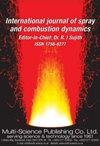热声非线性特征值问题的迭代解及其收敛性
IF 2.1
4区 工程技术
Q3 ENGINEERING, MECHANICAL
International Journal of Spray and Combustion Dynamics
Pub Date : 2022-03-01
DOI:10.1177/17568277221084464
引用次数: 1
摘要
热声算子的谱由一个非线性特征值问题控制。热声界提出了一些不同的策略来解决这一问题,并确定热声本征模的频率和增长率。这些策略通常需要使用迭代算法,迭代算法需要初始猜测,并且不一定保证收敛到特征值。然而,这些方法的收敛特性之间的定量比较从未被提及。通过使用基于伴随的灵敏度,在本研究中,我们导出了一个显式公式,该公式可用于量化迭代方法在特征值附近的行为。特别地,我们使用Banach的不动点定理来证明存在无法通过文献中提出的一些迭代方法来识别的热声特征值,特别是不动点迭代,无论所提供的初始猜测的准确性如何。然后,我们介绍了一系列迭代方法,称为Householder方法,牛顿方法是其中的一个特例。使用这些方法所需的系数是通过基于高阶伴随的微扰理论明确推导的。我们演示了如何始终保证这些方法收敛到最接近的特征值,前提是初始猜测足够准确。我们还从数值上展示了特征值的吸引域如何随着所采用的Householder方法的阶数而变化。本文章由计算机程序翻译,如有差异,请以英文原文为准。
Iterative solvers for the thermoacoustic nonlinear eigenvalue problem and their convergence properties
The spectrum of the thermoacoustic operator is governed by a nonlinear eigenvalue problem. A few different strategies have been proposed by the thermoacoustic community to tackle it and identify the frequencies and growth rates of thermoacoustic eigenmodes. These strategies typically require the use of iterative algorithms, which need an initial guess and are not necessarily guaranteed to converge to an eigenvalue. A quantitative comparison between the convergence properties of these methods has however never been addressed. By using adjoint-based sensitivity, in this study we derive an explicit formula that can be used to quantify the behaviour of an iterative method in the vicinity of an eigenvalue. In particular, we employ Banach’s fixed-point theorem to demonstrate that there exist thermoacoustic eigenvalues that cannot be identified by some of the iterative methods proposed in the literature, in particular fixed-point iterations, regardless of the accuracy of the initial guess provided. We then introduce a family of iterative methods known as Householder’s methods, of which Newton’s method is a special case. The coefficients needed to use these methods are explicitly derived by means of high-order adjoint-based perturbation theory. We demonstrate how these methods are always guaranteed to converge to the closest eigenvalue, provided that the initial guess is accurate enough. We also show numerically how the basin of attraction of the eigenvalues varies with the order of the employed Householder’s method.
求助全文
通过发布文献求助,成功后即可免费获取论文全文。
去求助
来源期刊

International Journal of Spray and Combustion Dynamics
THERMODYNAMICS-ENGINEERING, MECHANICAL
CiteScore
2.20
自引率
12.50%
发文量
21
审稿时长
>12 weeks
期刊介绍:
International Journal of Spray and Combustion Dynamics is a peer-reviewed open access journal on fundamental and applied research in combustion and spray dynamics. Fundamental topics include advances in understanding unsteady combustion, combustion instability and noise, flame-acoustic interaction and its active and passive control, duct acoustics...
 求助内容:
求助内容: 应助结果提醒方式:
应助结果提醒方式:


